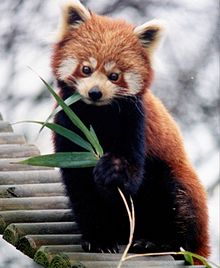***The opinions shared on this blog are mine alone, and are not endorsed by the Kanas City Zoo.
International Red Panda Day 11/13/10
 Have you ever seen a more adorable animal?
Have you ever seen a more adorable animal? This is a Red Panda. We are lucky enough to have two darling red pandas at the Kansas City Zoo, Fagan a 10 year old male, and Wen Dee an 11 year old female. (We hope that they do what males and females do sometime next month, and that Wen Dee will have a cub ot two in June.)
When I'm interpreting about these animal's I often find that people have no idea what a Red Panda is. That's not surprising, since for it wasn't until recently that science knew what they were. They were at one time considered a cousin of the Giant Panda and part of the Ursidae (bear) family. They have been also been called "firefox" which would make them Canidae (dog) family. Bearcat (Felidae) cat family. And many people think they are a relative of the racoon, (Procyonidae) family. But DNA testing showed that they are in a family all by themselves. The family Ailuridae.
The trouble is that they are endangered mainly by deforestation in their natural environment. If they become extinct then a whole family will be wiped out. That's why Saturday 11/13/10 was the first International Red Panda Day. Sponsored by The Red Panda Network http://redpandanetwork.org/redpanda/red-panda-ranger/. Zoos around the world participated and children had a chance to become Red Panda Rangers. Your kids might find these activities too.

I could go on forever about the wonders of this precious little animal that's about the same size as a cat. They are so secretive that for years naturalists had difficulty studying them. But they have been found in the foot hills of the Himalayas in Myanman, Nepal, Bhutan, and China. They eat almost exclusively bamboo leaves (up to 200,000 per day), and spend the rest of their time sleeping in the trees.
Their dense coat is so thick, even covering the inside of their ears and the soles of their feet, they can suffer heat stroke in temperatures above 80 degrees. (In Kansas City they have an air conditioned exhibit in summer and an outdoor exhibit in winter.)
I could go on and on, but they sure are cute aren't they. I hope you like my new feature, and if you have any questions about Red Pandas don't hesitate to ask.
What a wonderful thing to do, I would love to have the opportunity to do something like this though i have to say my stint as a volunteer with our local animal rescue centre was rewarding if not at times totally heartbreaking. How adorable are these pandas. Is it beacause of the ring around their eyes that they were once thought to be related to the black and white giant panda?
ReplyDeleteAWWWW (love that you have that background). I would have soo said fox with that first picture!
ReplyDeleteAwesome photos and what a great volunteer job.
ReplyDeleteAwwwww red pandas are so adorable and so endangered, poor things!!! This is a great feature to your blog!! I look forward to more!!
ReplyDeleteYay for you volunteering - that's just wonderful!!!!
Take care
x
Thanks for the feedback. This is the best volunteer job ever.
ReplyDeleteTracy asks a great question about why Red Pandas were thought to be related to Giant Pandas.
The main reasons are that they do have many things in common. 1) They are both native to the mountains of China 2) They both eat almost exclusively bamboo 3) They both have an expanded wrist bone that allows them to articulate their front paws in, almost like they had thumbs. This makes holding onto bamboo easier. 4) They both have carnivor teeth and digestive tract, even though they eat mostly bamboo.
These things are probably all due to the fact that they both live in the same place, where there's not much food except bamboo, so they both made the necessary adaptations to eat it, but at first it seemed like they must be related. But while Giant Pandas are true bears, Red Pandas are all on their own branch of the taxonomy tree.
Aww, that animal is adorable! Thank you so much for this post because I didn't know much about the Red Panda.
ReplyDeleteI love the title of this Tuesday feature!
Jai